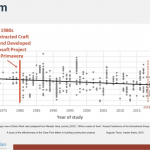(Hal Macomber, EVP, Touchplan with Mark Jussaume, VP, Office Director, SmithGroup) Some of the most important decisions are taken at the early stages of projects. This is true when we bring architects and engineers together for conceptual and schematic design. It’s true when a general contractor assembles trade partner foremen together for the first phase pull planning. To get the most out of these sessions care must be taken to tap the available perspectives, expertise, and judgments. Otherwise, we fall short of what we could be doing for our clients. The challenge is larger as we pursue industry-wide change. In 2004 when we wrote the Five Big Ideas Transforming the Design and Construction Industry we claimed,
The chief impediment to transforming the design and delivery of capital projects is an insufficient relatedness of project participants. Participants need to develop relationships founded on trust if they are to share their mistakes as learning opportunities for their project, and all the other projects.
While the industry made great strides, the challenge remains. Change the people to change the projects and the industry.
My Prior Guidance for “Intentionally Build Relationships on Projects”
Whether you are a leader or team member see to it that you take the time upfront to build your team. What does that take? Try these five steps:
- Explore each others’ personal intentions and ambitions. Projects offer sufficient opportunities to take care of individual needs and desires. We just need to find out what they are. Then bring those intentions into alignment with the promise of the project.
- Cultivate practices of commitment-making. At the very first opportunity begin practices of making promises in front of each other. This practice provides a factual basis for making assessments of trustworthiness and care for the team.
- Make it your habit to acknowledge and appreciate team members. Become a mutual admiration society. High-performing teams are characterized as environments where people are acknowledged at least once every seven days for the talents, efforts, and contributions each team member brings.
- Foster an environment for healthy conflict. Encourage team members to express alternate views. Even in the face of the agreement have someone create a different perspective.
- Make the project setting a place where people can be their authentic selves without fear of judgment or mockery. Granting each other their legitimacy is the basis for the healthiest of relationships.
Our New Guidance for Bringing an Outward Mindset to our Projects
Perhaps you’ve made the statement, “change behavior and you’ll change results.” My prior guidance only focused on the actions we want from people. That was good as far as it went, but it was not far enough. When we change our minds, we change our actions.
Mark Jussaume leads the Boston office for SmithGroup. The people in that office stand out in their community, markets, and on their projects for bringing an outward mindset to their interactions with each other and those on their projects. In this mindset, we see people as people, with their own wants and needs, expertise and perspectives, purposes and ambitions, and cares and concerns. This contrasts with an inward mindset where we have our attention only on those issues for ourselves. When we’re inward others appear as objects or obstacles in our way. Mark says,
Bringing an outward mindset to projects is a force multiplier for changing behaviors.
It starts with caring enough about others to be helpful. That entails:
- See people as people, as a human, with goals and aspirations like me.
- Be considerate, helpful, attentive, and thoughtful.
- Be curious around others. Suspend advocacy in favor of inquiry.
- Take accountability for your impact on others.
- Take care of others while you take care of yourself.
- It’s an “our work” disposition.
We move from outward to inward when we become self-focused.
- “When we turn inward,” Mark says, “we tend to behave in ways that are less helpful such as subtly holding back information or we don’t bring up issues that might make us look bad.”
- “Other people become vehicles to get what we want, obstacles in our way or even irrelevant to us. We start to think in terms of “my work” as opposed to “our work”.
Some people might confuse an outward mindset with simply being kind or pleasant to work with. Having an outward mindset means that other people matter like I matter and by conceiving our work in this way we can achieve amazing results for ourselves and others.
Now, look back at the above five recommendations I made. Notice that each one of them is easier in an outward mindset — we are taking care of ourselves and the client — than the inward mindset — I need to have a productive work session. It’s also true that bringing about the conditions for conducting projects as high-functioning networks of commitments — a no-blame, learning-first, one for all, and all for one environment — is possible when we turn our mind outward. (See last week’s post, Conduct Projects as Networks of Commitments.)
Bringing an outward mindset requires practice for it to be always available. It takes work. For us, it’s the work of choosing, again and again, to be outward. The behaviors just follow.
Learn more about an outward mindset from this delightful 10-minute video Why I [Wish I Could] Hate Arbinger and from Arbinger’s books, The Outward Mindset: Seeing Beyond Ourselves, Leadership and Self-Deception: Getting Out of the Box, The Anatomy of Peace: Resolving the Heart of Conflict.
To see the outward mindset in action, read the Sparrow Hospital Case Study. You’ll see the outward mindset that the Granger Construction team brought to the renovation and how that mindset permeated to everyone else involved. Learn how you can get more value from Touchplan by using Custom Fields and how they make tracking progress on repetitive scopes easier; written by Andrew Piland from our Sales Engineering team. If you missed last week’s post, be sure to read Conduct Construction Projects as a Network of Commitments.
If you would like to revisit any of the posts from the Revisiting the Five Big Ideas series you can find all of them below.
- Part 1: Transforming the Design and Construction Industry
- Part 2: Collaborate; Really Collaborate
- Part 3: Tightly Couple Learning with Action
- Part 4: Optimize the Project as a Whole
- Part 5: Conduct Construction Projects as a Network of Commitments
- Part 6: Bring an Outward Mindset to All Interactions
- Part 7: Project Production Thinking Behind the Five Big
- Part 8: Pursue Project Outcomes at the Intersection of the Five Big Ideas
- Part 9: Adopting the Five Big Ideas on Your CM/GC Projects
- Part 10: What Comes After The Five Big Ideas?










